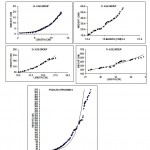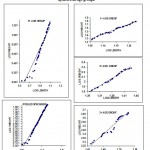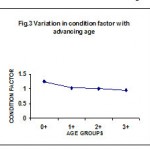How to Cite | Publication History | PlumX Article Matrix
Roopma Gandotra, Ravi Shanker, Shiraz Ahmed and Shakti Sagar
Department of Zoology, University of Jammu, Jammu - 180 006 India.
Corresponding Author E-mail: ravizoology@yahoo.com
ABSTRACT: The present work describes Length-weight relationship and Condition factor in different age groups of Tor putitora (Ham.) from Jhajjar stream, a tributary of River Tawi. The work was carried out on about 300 specimens ranging from 2.5 cm to 38.5 cm of length and 1.02 gm to 520.81 gm of body weight respectively. The values of correlation coefficients indicated a high degree of correlation between length and weight in different age groups viz. 0.957 (0+ age group), 0.994 (1+ age group), 0.995 (2+ age group), 0.968 (3+ age group) and 0.993 (pooled specimens). The Parabolic equations obtained were W= 0.04416 L2.311(0+ age group), W= 0.01268 L2.909(1+ age group), W= 0.00787 L3.068 (2+ age group), W= 0.00465 L3.199(3+ age group) and W= 0.01570 L2.835 (Pooled) and the Regression equations were Log W= -1.355+2.311 log L (0+ age group), Log W= -1.897+2.909 Log L (1+ age group), Log W= -2.104+3.068 Log L (2+ age group), Log W= -2.332+3.199 Log L (3+ age group) and Log W= -1.804+2.835 Log L (Pooled). Except for deviation in 0+ age group, the fish was observed to follow cube law. The condition factor (K) was found to decrease with the advancing age.
KEYWORDS: Length-weight relationship; cube law; condition factor
Download this article as:| Copy the following to cite this article: Gandotra R, Shanker R, Ahmed S, Sagar S. Studies On Length-Weight Relationship and Condition Factor in Different Age Groups of Tor Putitora (Ham.) from Jhajjar Stream, Jammu (J&K). Biosci Biotechnol Res Asia 2008;5(2) |
Introduction
Relationship between Length and weight in fishes helps: to determine the type of mathematical relationship between the two variables so that if one variable is known the other could be computed, to know the well being of fish (condition factor) and to know the type of growth (Allometric or Isometric). Further, there is general expectation that the weight increases as the cube of the length (Rousenfell & Everhart, 1953; Brown, 1957). But as the fishes pass through several stages, the simple cube law doesn’t hold well throughout the life span and regression coefficient (b) shows certain variations (Martin, 1949). Therefore, to get an exact picture, an age wise study was carried out on length-weight relationship and condition factor of Tor putitora (Ham.) from Jhajjar stream. Earlier many reports are available on length-weight relationship in different fish species (LeCren, 1951; Javaid & Akram, 1972; Johal & Tandon, 1981; Bhagat & Sunder, 1983; Gairola et al., 1990; Pandey & Sharma, 1998; Kar and Barbhuiya (2000), Sunil, 2000; Zafar et al, 2001,03; Johal et al., 2005; Malviya et al., 2006 and Deepak et al., 2007).
Materials and Methods
The present study was conducted on nearly 300 specimens of Tor putitora (Family: Cyprinidae) ranging from 2.5 cm to 38.5 cm of length. The fishes were collected monthly (April 2004 to March 2006) from Jhajjar stream, a tributary of river Tawi at a distance of about 35 km. from Jammu (J&K). The area is located between 320 49′ 6” to 320 52′ 20” North latitudes and 740 57’49” to 750 4′ 34″ East. The collections were made using cast net and hand net. The fishes were then brought to the laboratory where they were weighed after soaking water with the help of a blotting paper. The statistical relationship between length and weight of fishes was established using the following formula:
W= aLb (LeCren, 1951)
where W=Weight of the fish, L= Length of the fish, a= constant and b= Regression coefficient
For the practical purpose, this relationship is usually expressed in its logarithmic form:
Log W = Log a+b Log X (LeCren, 1951)
The correlation coefficient ‘r’ was calculated by using standard statistical methods.
The condition factor was determined by the formula:
![]() where L= length in cm and W= weight in gm.
where L= length in cm and W= weight in gm.
Age determination: Age was determined by counting the growth rings on the scales, which were taken from the second or third row beneath the origin of dorsal fin just above the lateral line (Johal & Tandon, 1985; Rawat & Nautiyal, 1996).
Results and Discussion
Age determination
Based on the study of scales all the 300 specimens of fish were grouped into different age groups (Table 1). First scale formation was observed in fish larva of about 2.5 cm Total length (TL). First annulus/growth ring was found to start forming at 12.5 cm. TL, second at 18.5 cm TL, third at 27.6 cm TL and fourth at 38.6 cm TL. Therefore, fishes from 2.5 cm to 12.4 cm TL with 8.45 cm as mean length were designated as 0+ age group due to the absence of growth ring, fishes from 12.5 cm TL to 18.5 cm TL with 15.44 cm as mean length were grouped as 1+ year age class due to the presence of one growth ring. The fishes from 18.6 to 27.5 cm with 22.96 cm as mean length were designated as 2+ year age class due to the presence of 2 growth rings. Finally, the fishes from 27.6 to 38.5 cm with 33.04 cm as mean length were designated as 3+ year class due to the presence of 3 growth rings. Due to the non-availability of fishes beyond 39 cm TL, the studies were restricted up to 38.5 cm (maximum TL for 3+ age group) only.
Table 1: Different Age groups along with the number & percentage and condition factor in each group.
| Age
Groups |
Length range (cm) | NUMBER &
PERCENTAGE |
CONDITION
FACTOR |
||
| Min. | Mean | Max. | |||
| 0+ | 2.5 | 8.45 | 12.4
|
80 (26.67%) | 1.24 |
| 1+ | 12.5 | 15.44 | 18.5
|
130 (43.33%) | 1.02 |
| 2+
|
18.6
|
22.96
|
27.5 | 55 (18.33%) | 1.01 |
| 3+ | 27.6 | 33.04
|
38.5 | 35 (11.67%) | 0.96 |
 |
Figure 1: Parabolic relationship between Length (cm) and Weight (gm) of Tor putitora (Ham.). in different age groups.
|
Length-weight relationship
Whereas the smallest specimen with 2.5 cm TL possessed 1.02 gm Total weight (TW), the largest specimen studied was found to show 520.81 gm TW. When the natural values of length of all the groups were plotted together (pooled form) against weight, a curvilinear relationship was obtained although the plots for individual age groups revealed almost linear relationships between these parameters. Such differential graphical results are due to the fact that each age group plot represents a section of the pooled data. However, when both the variables were plotted against each other in their logarithmic forms, straight lines were obtained in all the cases. A high degree of positive correlation was observed between length and weight in all age groups, which could be inferred from their higher correlation coefficients (Table 2). The values of regression coefficient (b) for these groups were 2.311 (0+ age group), 2.909 (1+ age group), 3.068 (2+ age group), 3.199 (3+ age group) and 2.835 (pooled specimens).
Table 2: Average length, average weight, correlation coefficient and Parabolic & Regression equations for different age groups.
| GROUP | AVERAGE | AVERAGE | CORRELATION | PARABOLIC | REGRESSION EQUATION |
|
LENGTH |
WEIGHT |
COEFFICIENT (r) |
EQUATION
(W=a Lb) |
(Log W= log a+ b log X) |
|
| 0+Age group | 8.45 ± 2.67 | 7.54 ± 5.62 | 0.957 | W= 0.04416 L2.311 | Log W= -1.355+2.311 log L |
| 1+Age group | 15.44 ± 1.80 | 37.76 ± 12.54 | 0.994 | W= 0.01268 L2.909 | Log W= -1.897+2.909 log L |
| 2+Age group | 22.96 ± 2.63 | 122.71 ± 42.27 | 0.995 | W= 0.00787 L3.068 | Log W= -2.104+3.068 log L |
| 3+Age group | 33.04 ± 2.94 | 346.66 ± 96.79 | 0.968 | W= 0.00465 L3.199 | Log W= -2.332+3.199 log L |
| Pooled | 18.49 ± 9.83
|
114.42 ± 142.12
|
0.993 | W= 0.01570 L2.835 | Log W= -1.804+2.835 log L |
 |
Figure 2: Logarithmic relationship between Length and Weight of Tor putitora (Ham.). in different age groups.
|
Allen (1938) suggested that for an ideal fish following ‘cube law’ the value of ‘b’ remains constant at ‘3’. But Hile (1936) and Martin (1949) illustrated that the value of ‘b’ usually ranges between 2.5 and 4.0 and in majority of the cases ‘b’ is not equal to 3. The value of b<3 represents that fish becomes less rotund as length increases and the value of b>3 represents that fish becomes more rotund as length increases. In both the cases, the dimensions of fish change with growth. If ‘b’ equals 3, growth may be Isometric meaning that the fish grows equally in all directions in the form of a cube. Rounsefell & Everhart (1953) and Ali et al. (2000) have stated that most of the fishes change their shape with respect to their body proportions during growth in their life. Therefore, such “Cube” relationship does not hold true. The reasons for such variations are said to be due to seasonal fluctuations in environmental parameters, topography, taxonomic differences in small populations, physiological conditions at the time of collection, sex, gonadal development and nutritive condition of the environment of the fishes (Sinha, 1973; Kaur, 1981; Dasgupta, 1982; Zafar et al., 2003).
It is evident from the present findings that although there are variations in the value of ‘b’ in different groups, yet the value remains close to ‘3’ in all the cases thereby showing that the fish follows ‘cube law’ and grows Isometrically except 0+ age group, which shows deviation from cube law (b= 2.311) and grows Allometrically which is due to less gain in weight than length in this group. Earlier many authors have reported Tor putitora to follow cube law viz. Nautiyal (1985), Dasgupta (1991), Tandon et al. (1993), Zafar et al. (2001) and Johal et al. (2005) from different water bodies studied by them.
Condition factor
Condition factor (K) is a physiological indicator of the well being of any fish living in a given environment. In the present case the values of ‘K’ for different age groups were found to be 1.24 (0+ age group), 1.02 (1+ age group), 1.01(2+ age group) and 0.96 (3+ age group) as shown in Table 1.The nearness of ‘K’ value to 1.0 clearly indicates the suitability of the environment for fish growth. The present findings are in conformity with those of Kumar et al. (2006). Further, there is decrease in ‘K’ value with the advancing age showing that there is less weight gain in comparison to the cube of length (Fig.3). The declining value of ‘K’ with increasing length has also been reported by MacGregor (1959), Javaid & Akram (1972) and Johal & Tandon(1981).Such a decline may be attributed to higher feeding rate in the juveniles, which falls gradually with size, as has also been proposed by Ghosh (1996) and Ghash & Zamadar (2003).
 |
Figure 3: Variation In Condition Factor With Advancing Age.
|
References
- Allen, K.R. (1938) Some observations on the biology of the trout (Salmo trutta) in Windomere. J. Anim. Ecol., 7: 333-349.
- Ali, M., A. Salam and F. Iqbal (2000) Weight-length relationship and condition factor of wild Channa punctata from Multan. Punjab Univ. J. Zool., 15: 183-189.
- Bhagat, M.J. and Shyam Sunder (1983) A preliminary note on length-weight relationship and relative condition factor of Schizothorax plagiostomus (Heckel) from Jammu region. J.Inl. Fish.Soc.India, 15(1-2):73-74.
- Brown, M.E. (1957) Experimental studies on growth. In: M.E.Brown (Ed.). The physiology of fishes.
- Dasgupta, M. (1982) An investigation on some aspects of the biology of the mahseers of the North-Eastern India. Ph.D. North-Eastern Hill University, Shilong.
- Dasgupta, M. (1991) Biometry of the mahseer Tor putitora (Ham.) collec-ted from Garo Hills, Meghalaya. Indian Fish. 38 (2): 129-131.
- Deepak, P.K., Samita Kapoor, U.K. Sarkar and T.A.Qureshi (2007) Length weight relationship and condition factor of endangered featherback Chitala chitala from different populations of North India. J. Aqua. Biol., 22(1): 65-69.
- Gairola, D., O.V. Singh, S.K. Malhotra, S. Nanda and R.P. Ghildiyal (1990) Parasite, Ponderal Index and length-weight relationship in B. bendelisis and P. ticto. Indian J. Fish., 37 (4): 361-365.
- Ghosh, S.K. (1996) Biology, Ecology and Culturability of Chocolate Mahseer Acrossocheilus hexagonolepis (McClell) from Umiam Reservoir, Meghalaya, India. Ph.D.Thesis submitted to the University of Calcutta.
- Ghosh, S.K. and Y.A. Zamadar (2003) Length-weight relationship, Length frequency and Condition of Chocolate Mahseer Neolissochilus hexagonolepis (McClelland) from Umiam Reservoir, Meghalaya, India.Indofish (3 & 4): 1-7.
- Hile, R. (1936) Age and growth of Cisco, Leucichthys artedi (Le seur) in the lake of the north eastern highlands, Wisconsin. U.S. Burr. Fish. Bull., 48: 211-317.
- Javaid, M.Y. and M. Akram (1972) The length-weight relationship and condition factor of seven fresh water fishes of Pakistan. Bull. Dept. Zool. Univ. Punjab, Pakistan, 6: 1-27.
- Johal, M.S. and K.K. Tandon (1981). Age, growth and length weight relationship of Tor tor (Ham.) from Gobindsagar, Himachal Pradesh (India). Pb. Fish, Bull., Special Publication ‘Coldwater Fisheries Seminar’ organized by C.I.F.E. at Chandigarh: 43-48.
- Johal, M.S. and Tandon, K.K. (1985) Use of growth parameters in Labeo rohita (Pisces, Cyprinidae).,49 : 101-107.
- Johal, M.S., R.K. Negi and S. Onkar (2005) Length-weight relationship of Golden Mahseer Tor putitora (Hamilton) from Pong Dam Reservoir, Himachal Pradesh. Uttar Pradesh Journal of Zool., 25(1): 85-88.
- Kar, D. and M.H. Barbhuiya (2000). Length-weight relationship and condition factor in Gadusia chapra (Ham.-Buch.) and Botia dario (Ham.-Buch.) from Chalta haor (Flood plain wetland) in Cachar district of Assam. Environment and Ecology, 18(1): 227-229.
- Kaur, S. (1981) Studies on some aspects of the ecology and biology of Channa gachua (Ham.) and Channel stewartii. Ph.D. Thesis. North-Eastern Hill University, Shilong.
- Kumar, R., B.K. Sharma, L.L. Sharma and B. Upadhyay (2006). Length-weight relationship and condition factor of Catla catla (Hamilton) and Labeo rohita (Hamilton) from Daya reservoir, Udaipur (Rajasthan).J.Inl.Fish. Soc. India, 38(1): 72-76.
- LeCren, E.D. (1951). The length-weight relationship and seasonal cycle in the age and growth of the perch (Perca fluviatilis) from the opercular bone. Journal of Animal Ecology, 20: 201-219.
- Martin, W.R. (1949). The mechanism of environmental control of body form of fishes.Univ. Toronto. Stud. Biol., 58. Publ. Ont. Fish. Res. Lab., 78: 1-91.
- MacGregor, J.S. (1959). Relationship between fish condition and population size in the sardine (Sardionops caerules). U.S. Fish & Wild Life. Ser. Fish. Bull., 60: 216-230.
- Malviya, M.K., V.R. Madlapure and U.M. Jayabhaye (2006). Length-weight relationship in Nemacheilus savanna and Macrones leucophasis of river Kayadhu in Hingoli district, Maharashtra. J.Aqua.Biol., 21(2): 149-152.
- Nautiyal, P. (1985). Length-weight relationship and relative condition factor of the Garhwal Himalayan mahseer with reference to its fishery. Indian Journal of Animal Sciences, 55(1) : 65-70.
- Pandey, A.C. and M.K. Sharma (1998) Applicability of cube law in length-weight relationship of four species of exotic carps. In: Proc. Natl. Acad. Sci. India, 68: 67-71.
- Rawat, V.S. and Nautiyal P. (1996). Age and growth rate determination from pectoral and dorsal region scales of a hill stream teleost Barelius bendelisis (Ham.) with a note on differences in their structure. Indian J. Fish., 43(2) : 171-178.
- Rounsefell, G.A. and W.H. Everhart (1953) “Fishery Science, its methodss and applications.” Publ. John Wiley & Sons, Inc., New York, Chapman & Hall Ltd. London: 444.
- Sinha, A.I. (1973) Length-weight relationship of a fresh water catfish, Clarias batrachus (Lin.). Indian J. Zootomy, 14(2): 97-102.
- Sunil, M.S. (2000) Length-weight relationship in Rasbora daniconius (Ham.) from Achancoil river, Pathanamthitta, Kerala, India. Indian J. Fish., 47(3): 271 – 274.
- Tandon, K.K. and Johal M.S. and Kukreja, T. (1993). Morphology age and growth of silver carp, molitrix (Val.) from Gobindsagar reservoir, H.P, India. Research Bulletin of Punjab University, 43 (I- IV): 117- 130.
- Zafar, M.A., Nazir, N., Akhtar and Rab, A. (2001). Weight-length and condition factor relationship of a freshwater wild mahseer, Tor putitora from Korang River Islamabad. Pak. J. Biol. Sci., 6 : 626-627.
- Zafar, M., Y. Mussaddaq, S. Akhter and A. Sultan (2003) Weight-length and condition factor relationship of thaila, Catla catla from Rawal Dam Islamabad, Pakistan. Pakistan Journal of Biological Sciences, 6(17): 1532-1534.

This work is licensed under a Creative Commons Attribution 4.0 International License.





